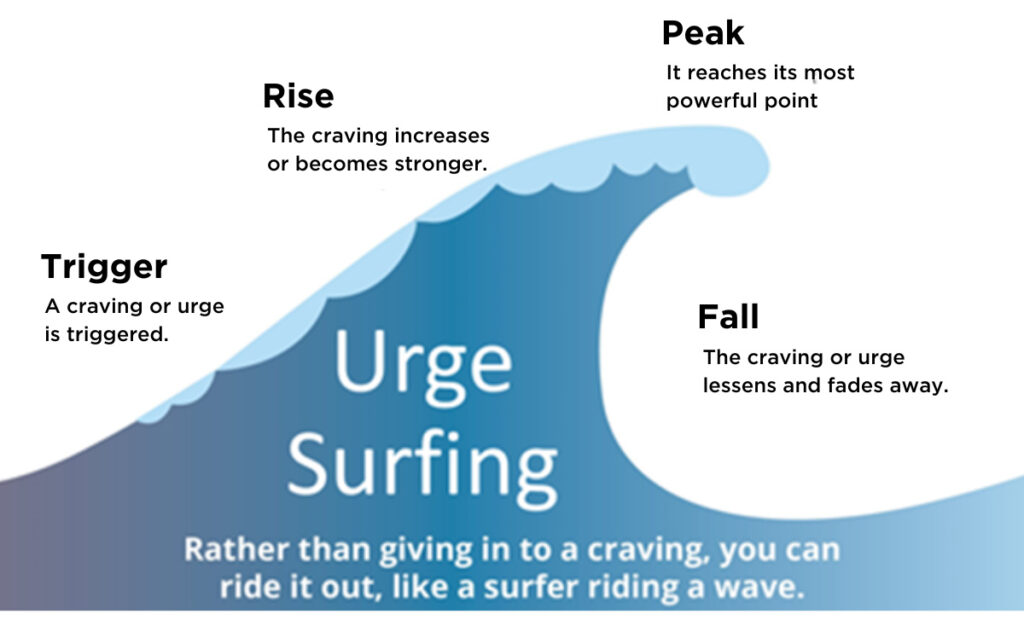The feeling hits you, and you have the strongest urge to succumb to your cravings. Inside and out your body aches to act on your habit, it is all you can think about. Changing a habit is hard, you know it as well as the next person. The cravings hit you like a truck and all you want to do is make this urge go away. Urge surfing is a cognitive coping practice that you can utilize when an urge hits you. Practicing urge surfing can teach you to cope with the thoughts, cravings, and emotions that you experience during your episode.
Urge surfing is a technique that you can use to help calmly understand your craving and accept it. By practicing mindfulness during your urge, you can learn to develop a sense of choice. You do not have to choose to slip or relapse, you can maintain your recovery.
Ride Your Wave
The name urge surfing comes from the idea that you are surfing on a wave. Your breath is your surfboard, and your urge is the wave. You are riding your surfboard, feeling the sensations, and shifting with it. As the waves rise, crest, and fall you ride it out breathing in and out.
Like the waves, your urges build and eventually crest and fall. The more you fight the wave, the more likely you are to fall. When you relax into your breathing or surfboard, you can ride out the urge no matter how intense the feeling is. It does not matter how tall the wave wall gets; it always has to crest.
How Do I Urge Surf?
When you feel an urge coming on, sit in a calm place and breathe, follow the natural flow of your breath without changing it. Remember, while you are practicing urge surfing you can always come back to your breath.
This is about being mindful and accepting the urge as it is instead of fighting it. Ride it out as a surfer would on a wave. After a few breaths, notice your thoughts and let them flow like the tide. What are they saying to you? Do not judge them or fight them, we are working on being positive, observing and describing the urge in a nonjudgmental and unattached manner.
Think about where the urge manifests itself:
· Where is the sensation located in your body? Is it only in one spot or many?
· How intense is the sensation?
· How does that sensation feel? Is it hot or cold? Is it firm or loose?
· How does it feel when you take a breath?
When you do this, you can focus on each body part involved. Breathe, think, feel, and repeat on another body part where it is manifesting. Notice if anything changes during your urge. Do not fear the urge, you can learn from it. It is more productive to try to understand your experience than fight it.
When you surf your craving, you learn from the craving and become more mindful of it. Urges will pass on their own like a wave. Urges seldom last longer than a half-hour, that is if you do not give it your attention.
By giving it attention, desire overwhelms you. Fighting your urges can make them bigger and unmanageable. Soon, it is all you can think about, it takes control of your thoughts, and it can feel like time is standing still. If you give in, you will reinforce the power of your addiction.
The more you repeat an action the better you become at it, the same goes for urge surfing. As you practice your mindfulness you can teach your brain that it does not have to act on its cravings, you gain control over your own thoughts and choices.
Dr. G. Alan Marlatt, a pioneer of urge surfing said, “We’re trying to promote approaches that will help people see their feelings and then develop more of a sense of choice. It is when they’re in the habit-stimulus response that most people get into drug use and its consequences.”
What’s Your Trigger?
When you are starting to have an urge or craving, it is important to ask yourself what your trigger is. One of the more substantial triggers that lead to relapse is being in a negative emotional state.
The important thing about urge surfing is not feeding your negative emotions, do not add to the pain you are already experiencing. Giving in to your urge would give you temporary relief but afterward, you would be suffering more, upset that you gave in.
Whether you are trying to change a distressing behavior or quit a habit, urge surfing is a great practice to avoid acting on your urges. Being mindful of your urge can help you reduce and even stop your habit altogether. With this method, you can help to reduce the possibility of a slip or relapse.

